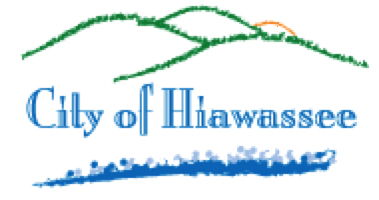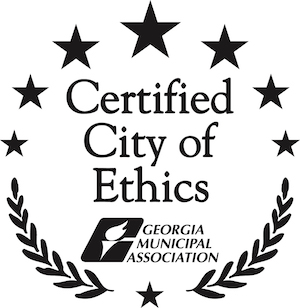Mayor Liz Ordiales welcomes you to the City of Hiawassee's website. Please explore our site to find information about the services we provide and how to attain them. You can also find out about your city government to include elected officials and hired staff. You can view recent city council agendas and minutes. Learn about the history of Hiawassee as well as facts about our population and geography. Additionally, you can find out information about doing business in Hiawassee.
The City of Hiawassee is an Equal Opportunity Employer.
- Details
- Category: Hiawassee News and Events
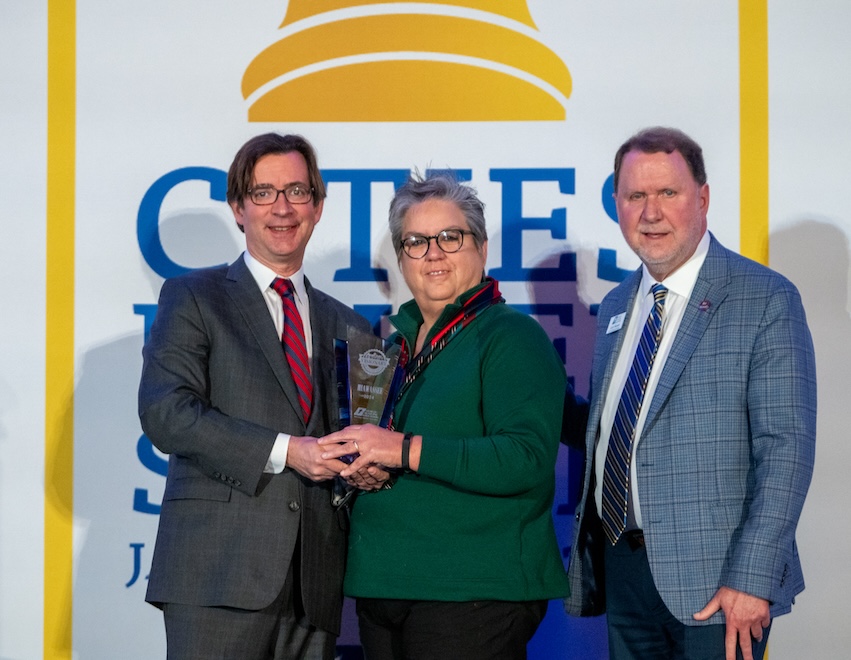 Hiawassee, Georgia – The City of Hiawassee is proud to announce that it has been honored with the prestigious 2024 Visionary City Award by the Georgia Municipal Association in partnership with Georgia Trend Magazine. This award, presented during the GMA’s Cities United Summit on January 28, recognizes Hiawassee’s significant achievements in fostering positive community change through effective civic engagement and collaboration.
Hiawassee, Georgia – The City of Hiawassee is proud to announce that it has been honored with the prestigious 2024 Visionary City Award by the Georgia Municipal Association in partnership with Georgia Trend Magazine. This award, presented during the GMA’s Cities United Summit on January 28, recognizes Hiawassee’s significant achievements in fostering positive community change through effective civic engagement and collaboration.
The City of Hiawassee was selected as a winner in the Small Cities Category for its innovative "Hikeawassee" project. This initiative has successfully transformed the city into a vibrant hub for Appalachian Trail hikers, significantly boosting the local economy during the off-season months.
Specific impacts from the "Hikeawassee" program include the introduction of free transportation for hikers, the enhancement of local businesses, and the establishment of weekly social events that foster community spirit. This project exemplifies Hiawassee's commitment to creative economic development and inclusive community engagement.
“The Visionary City Awards are a testament to the power of local governments working collaboratively with their communities to create meaningful improvements," said Larry Hanson, CEO and Executive Director of GMA. "Hiawassee’s 'Hikeawassee' project is a prime example of an initiative that leverages the city’s unique assets to benefit both residents and visitors."
“This initiative was a community effort brought to us from our businesses that suffer during the winter months in our area. It brought the community together to provide food on Mayor Mondays, Shuttle services and bring much needed revenues during our slowest months. We look forward to enhancing our offerings for the Class of 2024!”
For more information about Hiawassee’s "Hikeawassee" project, please contact Liz Ordiales at 706-896-2202
- Details
- Category: Hiawassee News and Events
To download a PDF of this report Click here
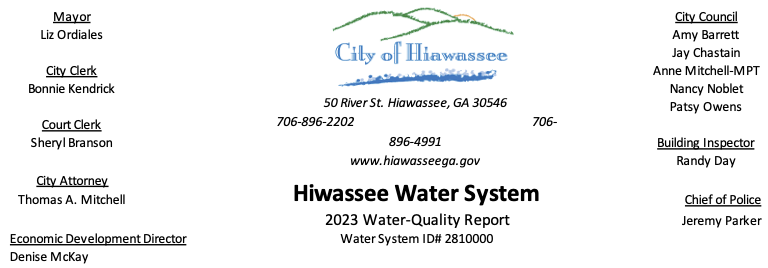
The City of Hiawassee is pleased to report that your community's drinking water met or exceeded all safety and quality standards set by the State of Georgia and EPA during the previous year. The City is pleased to present a summary of the quality of water provided to you during the past year. The Safe Drinking Water Act (SDWA) requires that utilities issue an annual "Consumer Confidence" report to customers. This report details where our water comes from, what it contains, and the risks our water testing and treatment are designed to prevent. The City of Hiawassee is committed to providing you with the safest and most reliable water supply. Informed consumers are our best allies in maintaining safe drinking water. We encourage public interest and participation in our community's decisions affecting drinking water. Regular City Council meetings occur at City Hall on the first Tuesday of each month at 6:00 p.m. The public is welcome.
Water Source: The City of Hiawassee's water system is suppled by surface water from one source, Lake Chatuge. Before entering the distribution system the water is treated at the Rowe Canupp treatment plant located in Hiawassee. The following chemicals are used in the treatment process; aluminum sulfate, soda ash, activated carbon, poly-phosphate, potassium permanganate and chlorine. In May 2000, a source water assessment was completed identify potential pollution sources which may pose a risk to Hiwassee's water source. A copy of the source water assessment report is available at City Hall.
How to Read this Table
The chart in this report provides representative analytical results of water samples, collected in 2023 unless otherwise noted from the city of Hiawassee Water System. Please note the following definitions:
Maximum Contaminant Level or MCL: The highest level of a contaminant that is allowed in drinking water. MCLs are set as close to the MCLGs as feasible using the best available treatment technology.
Maximum Contaminant Level Goal or MCLG: The level of contaminant in drinking water below, which there is no known or expected risk to health. MCLGs allow for a margin of safety.
Action Level: The concentration of a contaminant, which triggers treatment or other requirement, which a water system must follow.
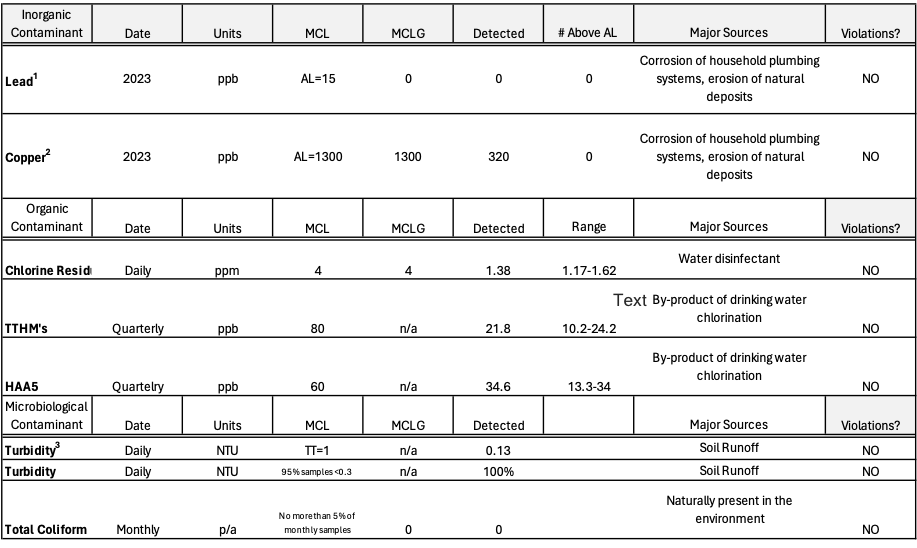
| Table Key | ||||
| AL = Action Level | ||||
| MCL = Maximum Contaminant Level | ||||
| MRDL = Maximum Residual Disinfectant Level | ||||
| MCLG = Maximum Contaminant Level Goal | ||||
| MRDLG = Maximum Residual Disinfectant Level | ||||
| ppm = parts per million or milligrams per liter (mg/L) | ||||
| ppb = parts per billion or micrograms per liter (ug/L) | ||||
| p/a = presence/absence (microbial) |
| Water-Quality Table Footnotes | |||
| 1 ppb of lead reported as the 90th percentile of samples taken | |||
| 2 ppb of copper reported as the 90th percentile of samples taken | |||
|
3 Turbidity is a measure of the cloudiness in water. We monitor turbidity because it is a good indicator of the effectiveness of our filtration system. |
|||
Required Additional Health Information:
To ensure that tap water is safe to drink, EPA prescribes limits on the amount of certain contaminants in water provided by public water systems. FDA regulations establish limits for contaminants in bottle water.
Drinking water, including bottled water, may reasonably be expected to contain at least small amounts of some contaminants. The presence of contaminants does not necessarily indicate that water poses a health risk. More information about contaminants and potential health effects can be obtained by calling the Environmental Protection Agency's Safe Drinking Water Hotline (800-426-4791). The sources of drinking water (both tap water and bottled water) include rivers, lakes, streams, ponds, reservoirs, springs, and wells. As water travels over the surface of the land or through the ground, it dissolves naturally-occurring minerals and radioactive material, and can pick up substances resulting from the presence of animals or from human activity. Contaminants that may be present in source water include:
(A) Microbial contaminants, such as viruses and bacteria, which may come from sewage treatment plants, septic systems, agricultural livestock operations, and wildlife.
(B) Inorganic contaminants, such as salts and metals, which can be naturally-occurring or result from urban storm runoff, industrial or domestic wastewater discharges, oil and gas production, mining, or farming.
(C) Pesticides and herbicides, which may come from a variety of sources such as agriculture, stormwater runoff, and residential uses.
(D) Organic chemical contaminants, including synthetic and volatile organics, which are by-products of industrial processes and petroleum production, and can also come from gas stations, urban stormwater runoff and septic systems.
(E) Radioactive contaminants, which can be naturally-occurring or be the result of oil and gas production and mining activities.
In order to ensure that tap water is safe to drink, EPA prescribes regulations which limit the amount of certain contaminants in water provided by public water systems. FDA regulations establish limits for contaminants in bottled water which must provide the same protection for public health.
Some people may be more vulnerable to contaminants in drinking water than is the general population. Immuno-compromised persons such as persons with cancer undergoing chemotherapy, persons who have undergone organ transplants, people with HIV/AIDS or other immune system disorders, some elderly, and infants can be particularly at risk from infections. These people should seek advice about drinking water from their health care providers. EPA/CDC guidelines on appropriate means to lessen the risk of infection by Cryptosporidium are available from the Safe Drinking Water Hotline (800-426-4791).
Lead in Drinking Water
If present, elevated levels of lead can cause serious health problems, especially for pregnant women and young children. Lead in drinking water is primarily from materials and components associated with service lines and home plumbing. The CIty of Hiawassee Water System is responsible for providing high quality drinking water, but cannot control the variety of materials used in plumbing components. When your water has been sitting for several hours, you can minimize the potential for lead exposure by flushing your tap for 30 seconds to 2 minutes before using water for drinking or cooking. If you are concerned about lead in your water, you may wish to have your water tested. Information on lead in drinking water, testing methods, and steps you can take to minimize exposure is available from the Safe Drinking Water Hotline or at http://www.epa.gov/safewater/lead.
National Primary Drinking Water Regulation Compliance
If you have any questions please call Liz Ordiales with the City of Hiawassee at (706) 896-2202, or e-mail at This email address is being protected from spambots. You need JavaScript enabled to view it.. Water Quality Data for community water systems throughout the United States is available at www.waterdata.com. Although a copy of this Water Quality Report will not be mailed to each individual customer, there will be copies available at Hiawassee City Hall. This report contains water quality information from the Rowe Canupp water treatment plant (WSID2810000).
 Este informed contiene information may important. Traduscalo o hable con un amigo quien lo entienda bien.
Este informed contiene information may important. Traduscalo o hable con un amigo quien lo entienda bien.
- Details
- Category: Hiawassee News and Events
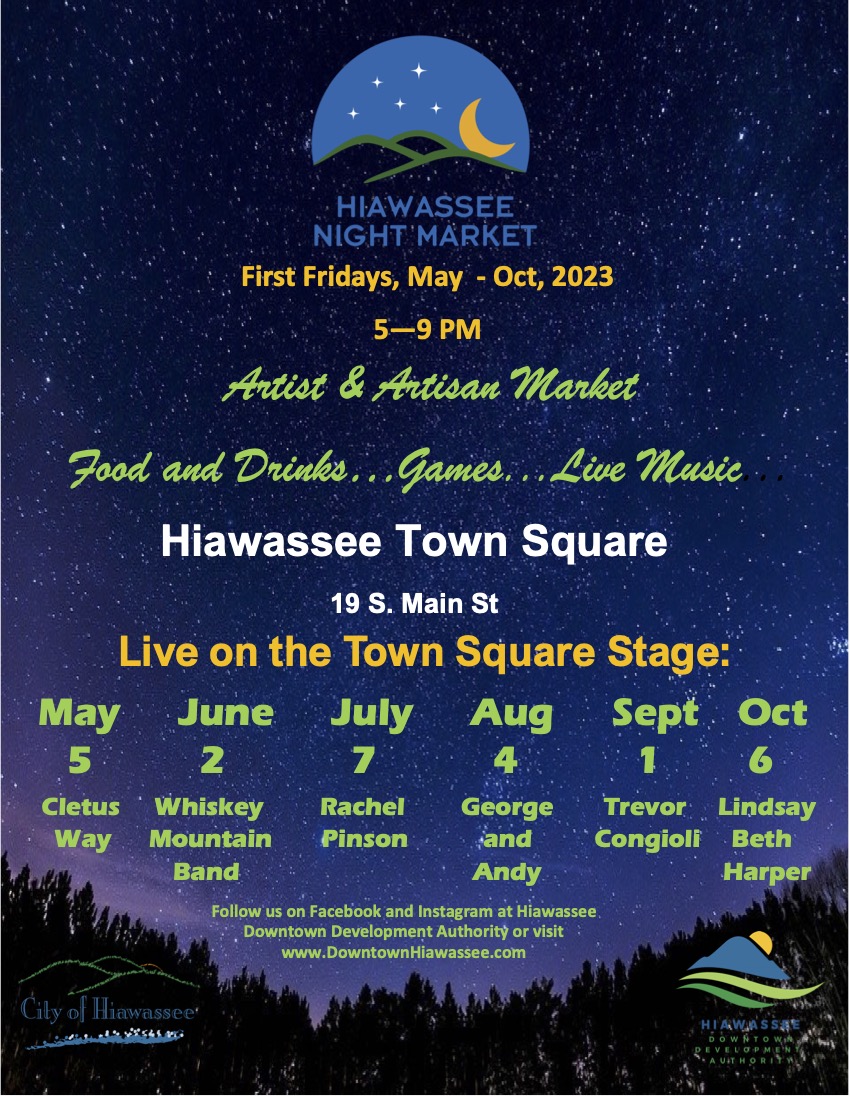
First Fridays, May - Oct, 2023 5—9 PM
Artist & Artisan Market
Food and Drinks...Games...Live Music...
Hiawassee Town Square 19 S. Main St
Live Music on the Town Square Stage
Follow us on Facebook and Instagram at Hiawassee Downtown Development Authority or visit www.DowntownHiawassee.com
- Details
- Category: Hiawassee News and Events

THE DAFFODIL PROJECT
RESILIENT, BRIGHT AND FILLED WITH HOPE, THESE DAFFODILS ARE A FART OF THE WORLDWIDE LIVING HOLOCAUST MEMORIAL THAT ASPIRES TO PLANT 1.5 MILLION DAFFODILS IN MEMORY OF THE 1.5 MILLION CHILDREN WHO PERISHED IN THE HOLOCAUST AND FOR CHILDREN WHO SUFFER IN HUMANITARIAN CRISIS AROUND THE WORLD TODAY.
